Sitting atop the approval process for prescription medications, Dr. Scott Gottlieb is a little different from some of his more bureaucratic predecessors: He’s listening.
Last month, the commissioner of the Food and Drug Administration hosted a public meeting to solicit input from patients, care providers, and drug makers on how to improve the FDA’s drug approval process and, just as importantly, expedite the introduction of generic drugs.
Far too often in Washington, regulators approach their mission by dictating terms to those in their purview. Gottlieb is different: His starting point is how the FDA can most efficiently get safe and effective treatments to the patients who need them. Improving the FDA’s processes can drive healthcare costs down dramatically and save millions of lives.
Take generics: Between 2005 and 2014, generics generated about $1.7 trillion in healthcare savings in America.
They also pressure rival products to lower their prices. One FDA study found that when a brand-name drug has eight generic competitors, patients buying the generic versions pay on average just 20 percent of the cost of the brand name. When a drug has only four generic versions, patients pay twice as much — 40 percent of the brand-name price.
And with only one generic competitor, generic buyers will see a minimal discount, paying on average 94 percent of the price of the brand-name. So in Gottlieb’s view, the more the better.
But speeding up generic approvals will be a challenge. The existing FDA channels are notoriously slow, gummed up with antiquated procedures. It’s been 30 years since the federal law governing generics has been significantly updated. The rules are especially unclear for complex generic drugs using delivery mechanisms that were invented only in the past few years.
This uncertainty lengthens the time it takes for a generic drug to win approval. The FDA is now staring down a backlog of 2,600 pending applications. Today, getting a new generic approved costs about $5 million and takes four years.
With delayed approval of generics, brand name drugs face less competition. For all too many drugs whose patents have expired, few companies if any have stepped up to create rival generic products. For about 10 percent of off-patent drugs, the FDA has received not a single generic application.
Without competition from other drug makers, manufacturers can charge monopoly-level prices even for decades-old medications. That’s exactly what happened with the price hike that brought “Pharma Bro” Martin Shkreli to national notoriety. Shkreli’s firm acquired the rights to produce the infection medication Daraprim — then immediately jacked up the price from $13 to $750. That hike only was possible because Daraprim had no real generic competition.
Commissioner Gottlieb has made ending the needless delays his top priority. His team has already started clearing out the application backlog and has announced plans to provide faster consideration for applications for drugs for which there are fewer than three firms currently making generics.
The FDA will also publish a list of off-patent drugs for which no company has applied to produce a generic version. The agency hopes that collecting that information and publicizing it will attract competitors into the market and also reduce the potential for life-threatening drug shortages.
Gottlieb is tackling a tough and urgent public health issue head on. And Congress is helping — specifically through reauthorizing the Prescription Drug User Fee Act (PDUFA), a breakthrough 1992 piece of federal legislation that requires drug companies to pay fees to cover the cost of the review and approval of their products.
Back in the early 90s, the FDA was drowning in drug applications. It didn’t have enough money or staff to review and approve medications in the pipeline. So Congress passed PDUFA to shore up the agency’s financing and expedite reviews. The bill worked. The average drug approval time fell from two and half years to just under 11 months. PDUFA has since helped usher 1,500 new drugs to market.
Re-authorizing PDUFA will give Gottlieb the resources he needs to make these reforms a reality. A life- and cost-saving revolution is now underway at the FDA.
Peter J. Pitts, a former FDA associate commissioner, is president of the Center for Medicine in the Public Interest.





